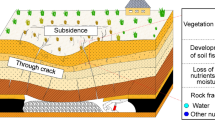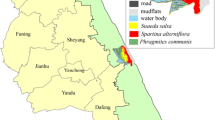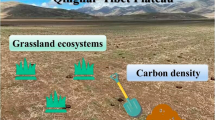Abstract
Saline wetlands are rare ecosystems in Saharan areas, which are important for conservation of many endemic and rare plant species. In this study, we investigated five saline wetland sites of the Oued Righ region, located in the northeastern Algeria, to determine the environmental factors controlling the composition and distribution of plant communities. We established a total of 20 transects to measure the vegetation parameters (density and cover) and soil characteristics (electrical conductivity, moisture, pH, CaSO4, CaCO3, organic matter, Na+, K+, Mg2+, Ca2+, SO4 2–, Cl–, NO3 – and HCO3 –). A total of 17 plant species belonging to seven families were identified. The natural vegetation was composed of halophytic and hydro-halophytic plant communities, presented specially by the species of Amaranthaceae family. Soils in the studied wetlands were moist, gypsiferous, alkaline, salty to very salty with dominance of chloride and calcium. Results of the Canonical Correspondence Analysis (CCA) showed that community structure and species distribution patterns of vegetation were mainly dependent on soil characteristics, mainly being soil salinity (CaSO4, K+, Ca2+ and Cl–) and moisture. The distribution of plant species was found to follow a specific zonal pattern. Halocnemum strobilaceum was observed to grow in highly salt-affected soils, thus being the more salt-tolerant species. Phragmites communis plants were widely distributed in the study area with a high density at the edges of accumulated water body. Juncus maritimus, Tamarix gallica and Salicornia fructicosa grew in soils that are partially or completely flooded in winter. Suaeda fructicosa, Traganum nudatum, Arthrocnemum glaucum, Aeluropus littoralis, Cressa cretica and Cynodon dactylon were distributed in salty and moist soils away from the open water body. Plants of Zygophyllum album, Limonastrirum guyonianum, Cornulaca monacantha, Cistanche tinctoria, Mollugo nudicaulis and Sonchus maritimus were found in soils with less salty and moisture. They constituted the outermost belt of vegetation in the studied wetlands. This study will provide a reference on introducing the salt-tolerant plant species as a fodder resource in saline habitats and regenerating the degraded saline wetlands.
Similar content being viewed by others
References
Abd El-Ghani M M, Amer W M. 2003. Soil–vegetation relationships in a coastal desert plain of southern Sinai, Egypt. Journal of Arid Environments, 55(4): 607–628.
Aboura R, Benmansour D, Benabadji N. 2006. Comparison and phyto-ecology of Atriplex of Oran (Algeria). International Journal of Mediterranean Ecology, 32: 73–84.
AFNOR. 1999. Soil Quality. Paris: AFNOR, 10–16. (in French)
Alkhverdiev F D. 1988. Indicational significance of mosaicism of meadows with dominance the Shoregrass (Aeluropus littoralis) in the coastal portion of flatland Dagestan. Soviet Journal of Ecology, 19: 191–194.
Arce M I, Gómez R, Suárez M L, et al. 2013. Denitrification rates and controlling factors in two agriculturally influenced temporary Mediterranean saline streams. Hydrobiologia, 700(1): 169–185.
Aubert G. 1978. Methods of Soil Analysis. Marseille: CRDP, 65–100. (in French)
Ayoub A T, Malcolm C V. 1993. Halophytes for Livestock, Rehabilitation of Degraded Land and Sequestering Atmospheric Carbon. Nairobi: UNEP Environmental Management Guidelines, United Nations Environment Programme. Nairobi, Kenya, 54–68.
Barrett G. 2006. Vegetation communities on the shores of a salt lake in semi-arid Western Australia. Journal of Arid Environments, 67(1): 77–89.
Bertness M D, Ellison A M. 1987. Determinants of pattern in a New England salt marsh plant community. Ecology Monographs, 57(2): 129–147.
Bertness M D. 1991a. Interspecific interactions among high marsh perennials in a New England salt marsh. Ecology, 72(1): 125–137.
Bertness M D. 1991b. Zonation of Spartina patens and Spartina alterniflora in New England salt marsh. Ecology, 72(1): 138–148.
Bisson J. 2003. Myths and Realities of a Coveted Desert, the Sahara. Paris: L’Harmattan, 72–93. (in French)
Brown G. 2006. The Sabkha vegetation of the United Arab Emirates. In: Khan M A, Böer B, Kust G S, et al. Sabkha Ecosystems. Volume II: West and Central Asia. Netherlands: Springer, 37–51.
Carreño M F, Esteve M A, Martinez J, et al. 2008. Habitat changes in coastal wetlands associated to hydrological changes in the watershed. Estuarine, Coastal and Shelf Science, 77(3): 475–483.
Chehma A. 2006. Catalogue of Spontaneous Plants in the Northern of Algerian Sahara. Dar Elhouda Ain M’lila, Algeria, 1–140. (in French)
Chenchouni H. 2012. Flora diversity of a lake at the Algerian low-Sahara. Acta Botanica Malacitana, 37: 33–44. (in French)
Chigani H K, Khajeddin S J, Karimzadeh H R. 2010. Soil-vegetation relationships of three arid Land plant species and their use in rehabilitating degraded sites. Land Degradation & Development, 23(1): 92–101.
Clarke L D, Hannon N J. 1967. The mangrove swamp and salt marsh communities of the Sydney District: I. Vegetation, soils and climate. Journal of Ecology, 55(3): 753–771.
Clarke L D, Hannon N J. 1970. The mangrove swamp and salt marsh communities of the Sydney District. III. Plant growth in relation to salinity and waterlogging. Journal of Ecology, 58(2): 351–369.
Cooper A. 1982. The effects of salinity and water logging on the growth and cation uptake of salt marsh plants. New Phytology, 90(2): 263–275.
Daget D, Poissonet J. 1991. Meadows and Pasture: Methods of Study. Montpellier: Institute of Botany, France, 285–324. (in French)
Darmody R G, Foss J E. 1979. Soil-landscape relationships of the Tidal Marshes of Maryland. Soil Science Society of America Journal, 43(3): 534–541.
Dubief J. 1953. Essay on Surface Hydrology in the Sahara. Algiers: Service Scientific Studies, 26–103.
Duchaufour P. 1977. Genesis and Classification of Soil. Paris: Masson and Cie, 355–462.
García N, Cuttelod A, Abdul Malak D. 2010. The Status and Distribution of Freshwater Biodiversity in Northern Africa. Gland, Switzerland, Cambridge, UK and Malaga, Spain: IUCN, 134–175.
Gardi R. 1973. The Saharan (3rd ed.). Paris: Kümmerly and Fery, 49–51. (in French)
González-Alcaraz M N, Jiménez-Cárceles F J, Álvarez Y, et al. 2014. Gradients of soil salinity and moisture, and plant distribution, in a Mediterranean semiarid saline watershed: A model of soil-plant relationships for contributing to the management. Catena, 115: 150–158.
Gounot M. 1969. Vegetation Studies: Survey Methods. Paris: Masson, 215–284. (in French)
Halis Y. 2007. Encyclopedia of plants for the region of Souf; Saharan plants of the great Eastern Erg. Algiers: El Oued, 142–195. (in Arabic)
Halitim A. 1988. The Soils of Arid Regions of Algeria. Alger: University Office Publication, 123–156. (in French)
Halitim A, Bensaid R, Bensaad A, et al. 2003. Gypsiferous soil (genesis, characterization and function). Report APAPEZA Laboratory. Algeria: University of Batna. 1–25. (in French)
Hamdi-Aissa B, Valles V, Aventurier A, et al. 2004. Soils and brine geochemistry and mineralogy of hyper arid desert playa, Ouargla Basin, Algerian Sahara. Arid Land Research and Management, 18(2): 103–126.
Heker H, Tomàs Vives P. 1995. The Status of Wetland Inventories in the Mediterranean Region. Slimbridge: Medwet Publication/IWRB Publication, 38.
Hoveizeh H. 1997. Study of the vegetation cover and ecological characteristics in saline habitats of Hoor-e-Shadegan. Journal of Research and Construction, 34(1): 27–31.
Khadraoui A. 2005. Water and Soil in Algeria (Management and Environmental Impact). Algiers: EMPAC Constantine, 210–213. (in French)
Khadraoui A. 2007. Soils and Hydraulic of Algerian Oasis; Characterization, Constraints and Development. Algiers: Dar Houma Alger, 122–125. (in French)
Khan M A. 1990. The relationship of seed bank to vegetation in a saline desert community. In: Sen D N, Mohammad S. Proceedings International Seed Symposium. India: Jodhpur, 135–145.
Khaznadar M, Vogiatzakis I N, Griffiths G H. 2009. Land degradation and vegetation distribution in Chott El Beida wetland, Algeria. Journal of Arid Environments, 73(3): 369–377.
Kherraze M E, Lakhdari K, Kherfi Y, et al. 2010. Floristic Atlas of the Righ Oued Valley by Ecosystem. Biskra: Scientific and Technical Research Centre for Arid Areas, 25–58. (in French)
Koull N, Chehma A. 2015. Soil-vegetation relationships of saline wetlands in North East of Algerian Sahara. Arid Land Research and Management, 29(1): 72–84.
Le Houérou H N. 1992. The role of saltbushes (Atriplex spp.) in arid land rehabilitation in the Mediterranean Basin: A review. Agroforestry Systems, 18(2): 107–148.
Le Houérou H N. 2001. Biogeography of the arid steppe land north of the Sahara. Journal of Arid Environments, 48(2): 103–128.
Malcolm C V, Choukr-Allah R. 1995. Characteristics and methods for determining the drilling species for particular sites. In: The Halophytes and Agriculture. New York: Marcel Dekker Inc., 97–114.
Ozenda P. 1991. Flora of the Sahara (3rd ed.). Paris: CNRS, 212–410. (in French)
Pennings S C, Callaway R M. 1992. Salt marsh plant zonation: The relative importance of competition and physical factors. Ecology, 73(2): 681–690.
Poupon H. 1980. Structure and Dynamics of the Woody Layer of a Steppe in the North of Senegal. Paris: ORSTOM, 300–319. (in French)
Quézel P, Santa C. 1962. New Flora of Algeria and the Southernmost Desert Areas. Flight 1 and 2. Paris: CNRS, 443–526. (in French)
Richards L A. 1954. Diagnosis and Improvement of Saline and Alkali Soils. Agriculture Handbook-No. 60. Washington: USDA; 160.
Rogel J Á, Alcaraz Ariza F, Ortiz Silla R. 2000. Soil salinity and moisture gradients and plant zonation in Mediterranean salt marshes of Southeast Spain. Wetlands, 20(2): 357–372.
Rogel J Á, Silla R O, Ariza F A. 2001. Edaphic characterization and soil ionic composition influencing plant zonation in a semiarid Mediterranean salt marsh. Geoderma, 99(1–2): 81–98.
Roshier D A, Robertson A I, Kingsford R T, et al. 2001. Continental-scale interactions with temporary resources may explain the paradox of large populations of desert waterbirds in Australia. Landscape Ecology, 16(6): 547–556.
Slimani N. 2008. Characterization of some properties to adapt in the mid Saharan of the major spontaneous perennials plants in the region of Ouargla. MSc Thesis. Ouargla, Algeria: University Kasdi Merbah.
Snow A A, Vince S W. 1984. Plant zonation in an Alaskan salt marsh: II. An experimental study of the role of edaphic conditions. Journal of Ecology, 72(2): 669–684.
Soltner D. 1989. The Bases of the Vegetable Production. Volume 1: Ground. Anger: CSTA, 186–192. (in French)
Tug G N, Ketenoglu O, Bilgin A. 2012. The relationships between plant zonation and edaphic factors in halophytic vegetation around Lake Tuz, Central Anatolia, Turkey. Rendiconti Lincei, 23(4): 355–363.
Ungar I A. 1998. Are biotic factors significant in influencing the distribution of halophytes in saline habitats? The Botanical Review, 64(2): 176–199.
Viellefon J. 1979. Analysis of Gypsiferous Soils. Pedology Series 17. Cahiers: ORSTOM, 195–201.
Youcef H, Lamine B M, Hocine B, et al. 2012. Diversity of halophyte desert vegetation of the different saline habitats in the valley of Oued Righ, Low Sahara Basin, Algeria. Research Journal of Environmental and Earth Sciences, 4(3): 308–315.
Author information
Authors and Affiliations
Corresponding author
Rights and permissions
About this article
Cite this article
Koull, N., Chehma, A. Soil characteristics and plant distribution in saline wetlands of Oued Righ, northeastern Algeria. J. Arid Land 8, 948–959 (2016). https://doi.org/10.1007/s40333-016-0060-5
Received:
Revised:
Accepted:
Published:
Issue Date:
DOI: https://doi.org/10.1007/s40333-016-0060-5




